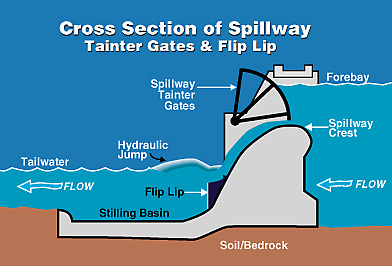Hydropower operations can be modified to improve in-river migration conditions for fish. During the juvenile fish migration seasons, from late March until fall, flows in the river are augmented, and water is spilled at the dams, to aid juvenile migration.
Flow Augmentation
Upstream storage dams hold back water for flood damage reduction and other uses, interrupting the seasonal river flow patterns. Seasonal releases of water from the dams, called flow augmentation, can aid salmon migration. The Corps operates two upstream storage dams, Dworshak Dam in Idaho and Libby Dam in Montana, which are used in flow augmentation for migrating juvenile salmon in accordance with the National Marine Fisheries Service Biological Opinion. Water is released in spring and summer months to improve flows in the Snake and Columbia Rivers. The Corps coordinates flow augmentation with the region through a Technical Management Team which meets weekly during the juvenile fish migration seasons to discuss flows and spills, and to plan operations for fish.
Spill for Fish
Another means of diverting fish from the turbines as they approach a dam is to spill water and juvenile fish over the dam spillways, rather than putting the water through the powerhouse to produce electricity. The Corps began spilling water for fish at several of its projects in 1977 as a way of improving juvenile fish passage survival. A more comprehensive spill program was initiated at the request of the region in 1989 when a long-term spill agreement was signed by Bonneville Power Administration, the fisheries agencies, tribes and others.
 Under the National Marine Fisheries Service Biological Opinion, spill at the dams has been increased substantially during juvenile fish migrations. But spill has associated risks because spilling water entrains air when the water plunges into the spillway basins, causing raised levels of gas supersaturation that can be harmful to fish. Spillway deflectors have been installed at five of the eight lower Columbia and Snake dams to produce a more horizontal spill flow and limit the plunge depth of water over the dam spillway, reducing the amount of entrained nitrogen. Installation of spillway deflectors has begun at two more dams. The Corps is also evaluating other potential gas abatement measures.
Under the National Marine Fisheries Service Biological Opinion, spill at the dams has been increased substantially during juvenile fish migrations. But spill has associated risks because spilling water entrains air when the water plunges into the spillway basins, causing raised levels of gas supersaturation that can be harmful to fish. Spillway deflectors have been installed at five of the eight lower Columbia and Snake dams to produce a more horizontal spill flow and limit the plunge depth of water over the dam spillway, reducing the amount of entrained nitrogen. Installation of spillway deflectors has begun at two more dams. The Corps is also evaluating other potential gas abatement measures.
Lower Snake River Dam Breach Study
In a seven year effort from 1995 - 2002 the Corps studied four major alternative ways to improve juvenile salmon passage through the hydropower system on the lower Snake River. One of the alternatives studied in the Lower Snake River Juvenile Salmon Migration Feasibility Study was breaching the four dams -- Lower Granite, Little Goose, Lower Monumental and Ice Harbor -- to return a 140 mile stretch of natural river. The other pathways evaluated were: maintain the existing system with planned improvements to fish passage systems; maximize barge/truck transport of juvenile fish around the dams; and, make major system improvements such as surface bypass systems for juvenile fish.
The Corps extensively evaluated the benefits, feasibility and potential impacts of breaching the dams and of the other alternatives. Initial evaluation included seasonal spillway crest level, seasonal natural river level, and permanent natural river level drawdowns of the Snake River dams. Of these, only the permanent natural river option, or dam breaching, was recommended for further examination, based on biological effectiveness, technical feasibility, cost, and other factors. The main obstacles to intermediate level drawdown such as spillway crest level were: 1) the need to make extensive and costly modifications to the fish passage systems at the dams, since fish bypass will continue to be necessary; and 2) evaluations which indicate that salmon survival would not be as high under intermediate drawdown scenarios as under current conditions.
To breach the lower Snake River dams, the earthen portion of each dam would be removed to return the river to a free-flowing state. The concrete-and-steel structures that currently provide power and navigation could remain in place but they would be inoperative. Barge traffic through the lower Snake to Lewiston, Idaho would be discontinued; power production would stop.
The Corps completed the Lower Snake River Juvenile Salmon Migration Feasibility Report/Environmental Impact Statement in September 2002. The study determined that the economic, user and environmental impacts of dam breach would be substantial, without an indication that the action by itself would recover listed stocks of salmon and steelhead. The Corps chose "adaptive migration" (major improvements to fish passage at the dams) as the preferred alternative. The Walla Walla District Web site has more information on the Lower Snake River Juvenile Salmon Migration Feasibility Study.